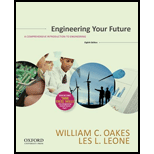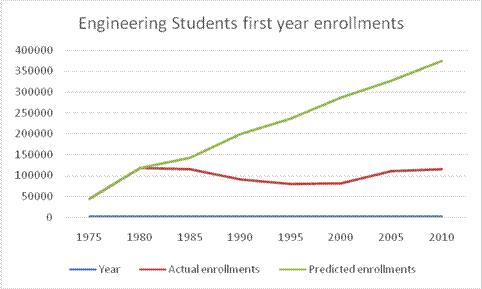
The number of first-year, full-time enrollments expected in 2010 if the administrator used the data from 1975 to 1980 and to calculate the percentage error.
Answer to Problem 3.1EAA
The number of first-year full time enrollments expected in 2010 if the administrator used the data from 1975 to 1980 as 375000 students and the percentage error is 226%.
Explanation of Solution
Given information:
As per the given data, to find the error percentage upon usage of the data from 1975 to 1980 to predict the number of first-year full time enrollments expected in 2010.
According to the data in the Engineering for your future book, the following table illustrates the actual data for the years 1975 to 2010 and the predicted data for the year 2010 using only the estimates from 1975 to 1980.
| Year | Actual enrollments | Predicted enrollments |
| 1975 | 45000 | 45000 |
| 1980 | 118000 | 118000 |
| 1985 | 115000 | 143000 |
| 1990 | 90000 | 200000 |
| 1995 | 80000 | 237000 |
| 2000 | 82000 | 287000 |
| 2005 | 110000 | 328000 |
| 2010 | 115000 | 375000 |
The following is a graphical illustration of the same data in the table:

The above graph shows huge differences in the predicted data since it has taken the data belonging to the years 1975 to 1980 and prorated the same to the rest of the years until 2010. By doing this, the administrator has missed few important factors like the number of births every year; number of high school graduates every year, and other economic factors. These factors tend to change year after year and by taking only the data from 1975 to 1980, the number of enrollments for several years cannot be predicted accurately.
The percentage of error can be calculated as:
Percentage error
This shows that there is a huge percentage error upon the usage of the data from 1975 to 1980 to predict the number of first-year full time enrollments expected in 2010.
Conclusion:
Thus, the number of first year full-time enrollments expected in 2010 if the administrator used the data from 1975 to 1980 and the percentage error is discussed in details.
Want to see more full solutions like this?
Chapter 3 Solutions
Engineering Your Future: Comprehensive
- PROBLEM 3.46 The solid cylindrical rod BC of length L = 600 mm is attached to the rigid lever AB of length a = 380 mm and to the support at C. When a 500 N force P is applied at A, design specifications require that the displacement of A not exceed 25 mm when a 500 N force P is applied at A For the material indicated determine the required diameter of the rod. Aluminium: Tall = 65 MPa, G = 27 GPa. Aarrow_forwardFind the equivalent mass of the rocker arm assembly with respect to the x coordinate. k₁ mi m2 k₁arrow_forward2. Figure below shows a U-tube manometer open at both ends and containing a column of liquid mercury of length l and specific weight y. Considering a small displacement x of the manometer meniscus from its equilibrium position (or datum), determine the equivalent spring constant associated with the restoring force. Datum Area, Aarrow_forward
- 1. The consequences of a head-on collision of two automobiles can be studied by considering the impact of the automobile on a barrier, as shown in figure below. Construct a mathematical model (i.e., draw the diagram) by considering the masses of the automobile body, engine, transmission, and suspension and the elasticity of the bumpers, radiator, sheet metal body, driveline, and engine mounts.arrow_forward3.) 15.40 – Collar B moves up at constant velocity vB = 1.5 m/s. Rod AB has length = 1.2 m. The incline is at angle = 25°. Compute an expression for the angular velocity of rod AB, ė and the velocity of end A of the rod (✓✓) as a function of v₂,1,0,0. Then compute numerical answers for ȧ & y_ with 0 = 50°.arrow_forward2.) 15.12 The assembly shown consists of the straight rod ABC which passes through and is welded to the grectangular plate DEFH. The assembly rotates about the axis AC with a constant angular velocity of 9 rad/s. Knowing that the motion when viewed from C is counterclockwise, determine the velocity and acceleration of corner F.arrow_forward
 Elements Of ElectromagneticsMechanical EngineeringISBN:9780190698614Author:Sadiku, Matthew N. O.Publisher:Oxford University Press
Elements Of ElectromagneticsMechanical EngineeringISBN:9780190698614Author:Sadiku, Matthew N. O.Publisher:Oxford University Press Mechanics of Materials (10th Edition)Mechanical EngineeringISBN:9780134319650Author:Russell C. HibbelerPublisher:PEARSON
Mechanics of Materials (10th Edition)Mechanical EngineeringISBN:9780134319650Author:Russell C. HibbelerPublisher:PEARSON Thermodynamics: An Engineering ApproachMechanical EngineeringISBN:9781259822674Author:Yunus A. Cengel Dr., Michael A. BolesPublisher:McGraw-Hill Education
Thermodynamics: An Engineering ApproachMechanical EngineeringISBN:9781259822674Author:Yunus A. Cengel Dr., Michael A. BolesPublisher:McGraw-Hill Education Control Systems EngineeringMechanical EngineeringISBN:9781118170519Author:Norman S. NisePublisher:WILEY
Control Systems EngineeringMechanical EngineeringISBN:9781118170519Author:Norman S. NisePublisher:WILEY Mechanics of Materials (MindTap Course List)Mechanical EngineeringISBN:9781337093347Author:Barry J. Goodno, James M. GerePublisher:Cengage Learning
Mechanics of Materials (MindTap Course List)Mechanical EngineeringISBN:9781337093347Author:Barry J. Goodno, James M. GerePublisher:Cengage Learning Engineering Mechanics: StaticsMechanical EngineeringISBN:9781118807330Author:James L. Meriam, L. G. Kraige, J. N. BoltonPublisher:WILEY
Engineering Mechanics: StaticsMechanical EngineeringISBN:9781118807330Author:James L. Meriam, L. G. Kraige, J. N. BoltonPublisher:WILEY





